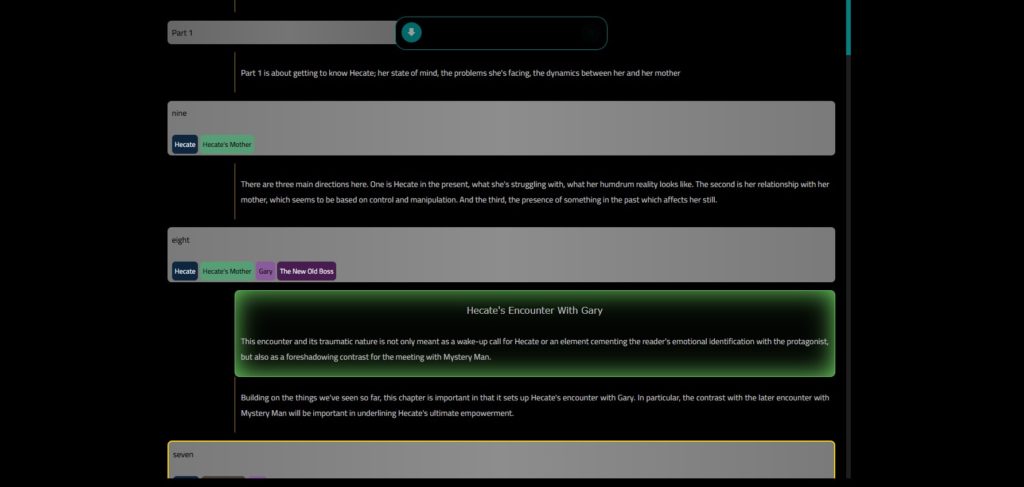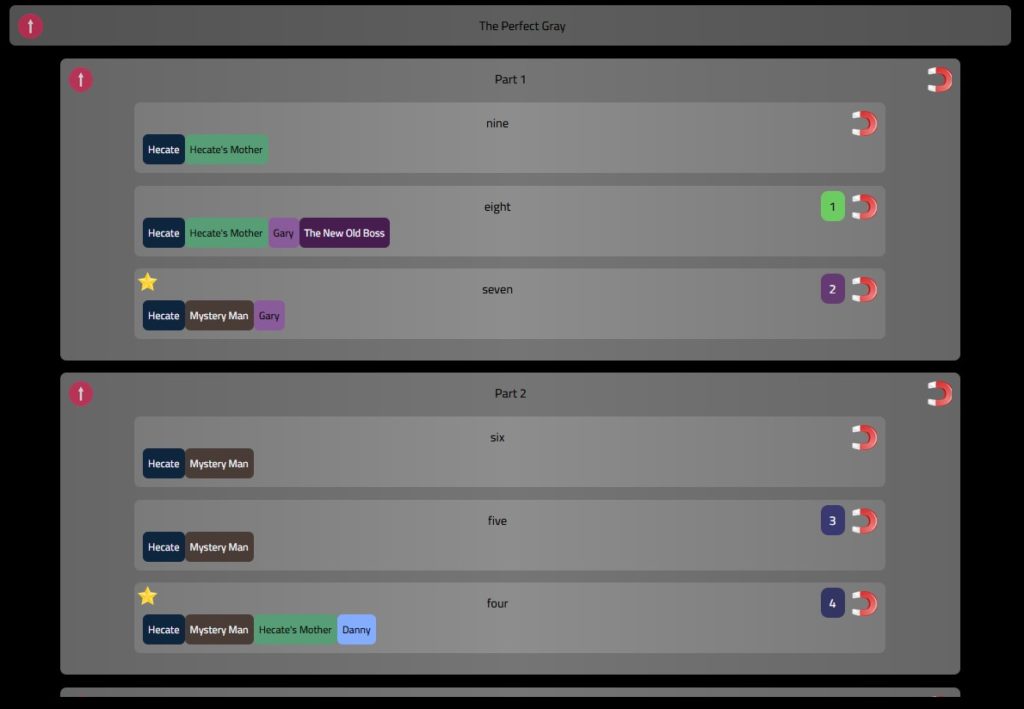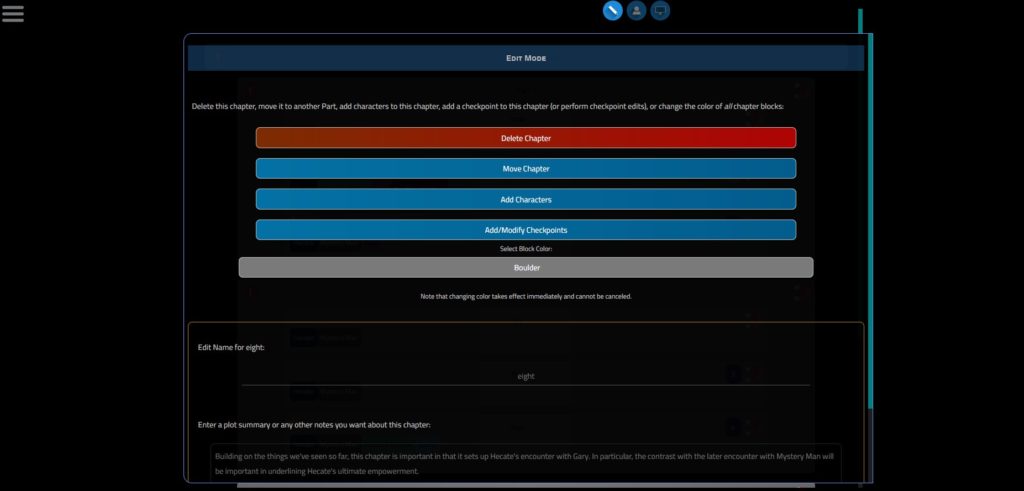January 23, 2023
Conceptualizer: a Free Story Planning Program
There are fiction authors who need to plan every, single, detail in advance – they’re called “plotters”. Then there are writers who write by their seat of their pants – hence they’re called “pantsers”. In reality, most authors fall somewhere in-between. The truth is, we all need some degree of planning for most works (except perhaps stream-of-consciousness or heavily experimental). And so, we could all benefit from a story planning program.
As with everything I make – programs, books, or blog posts – the intended audience of Conceptualizer, my free story planning program, was first and foremost myself. That is, I started to make a story planner because I felt I could benefit from one. I’m certainly not a plotter (though not a pantser either), but I like to keep some sort of notes regarding what will happen when.
And so, perhaps ironically, this sort of selfishness can be very useful to you, too! Let’s take a look at Conceptualizer, what it does and how it works, and at the end of this post I’ll include a link for you so that you can try it for free.

What a Story Planning Program Should Be Like
When I started thinking about the program and what I wanted it to contain, I focused on what I did before and how it could become better. So, at this point, allow me to offer you a sneak preview of how I used to plan my novels. It’s a bit like the “behind the scenes” I gave you about writing short stories, only this time more visual.
The collage below consists of screenshots from… Google Docs and my notes/diagrams for The Perfect Gray. Yes, it was as cluttered as it sounds and seems.
Warning: Though these are only notes and don’t necessarily reflect the actual final form of the novel, they still contain some minor spoilers. Although – as a literary fiction novel – The Perfect Gray doesn’t rely on plot, don’t read too carefully if you don’t want to know. For the same reason, the demo file of Conceptualizer doesn’t contain too specific details in part/chapter descriptions etc.

A Good Story Planning Program Should Be About Structure and Flow
Though I have the ability to contain in my head (and process) a massive amount of information, it’s stressing. What if I forgot something? Moreover, I didn’t like how scattered everything was in my Google Docs. I realized, I wanted to have a structured way of showing where the novel was going; a flow, if you like.
I wanted something like the top-left screenshot above (green color signifying I’ve taken care of that part), only in a more sense-making and inspiring manner.
More importantly, I realized I needed to have a way of understanding where it’s all going. That’s where checkpoints entered the picture.
If you recall my post on points of divergence in fiction, I there explained how the plot of every solid, cohesive narrative, can be basically outlined in a matter of 5-6 checkpoints. Think of them as very important events in the narrative, almost points of no return. As an example, here are 6 checkpoints we can come up with to describe Bram Stoker’s Dracula:
- Jonathan Harker goes to Transylvania
- He discovers Count Dracula is a vampire
- Dracula goes to England to create more vampires
- He attacks Mina
- Jonathan and his peers chase Dracula back to Transylvania
- They kill him
Identifying the checkpoints of your narrative is an immensely important part of your planning strategy. The better you are able to do that, the easier your writing will be and the more coherent your story.
Other Elements in Conceptualizer
Besides structure and flow – with checkpoints being, obviously enough, crucial parts in this flow – this story planning program also keeps track of characters: their descriptions, behavioral patterns, and all other sorts of information.
Here’s an example. This is again the demo file (The Perfect Gray), in Display Mode:

Of course, no story planning program would be complete without exporting capabilities. At any point, you can save all data you enter as an external file. The file is compatible with any device you access the program from. That is, you can work on your laptop, then save the file and send it to your mobile to continue from there. Handy!
Moreover, from Display Mode, there is the option to export the flow as an .html file – which is easy to read on any device and makes copy/pasting very easy.
And of course, Conceptualizer comes with a detailed help file, and plenty of customization options – I confess that I often got absentminded playing with color settings, rather than working on the code!



Try It for Free!
You can try Conceptualizer for free following this link. For a full list of my available programs, see the relevant page on the main site.
Like all my apps, this too is free and ad-free. Please consider dedicating a few minutes of your time to read about the ways you could support my work and why this is important for both of us. Thanks!

I just signed up again because it wouldn’t let me comment otherwise; however, I got your email about this post, so I KNOW I’m already signed up. Just so you know.
I’m an extreme plotter, and it has served me well in the long run. Glad you’ve found a way to make the plotting easier and keep track of the pieces.
A good novel, in my estimation, is a finely-tuned and oiled machine which, unlike real life which contains many of the same pieces but doesn’t make sense, makes some kind of sense the author is aiming at.
Keeping track of everything for someone like you who can hold a lot in your head at a time is doable; for me, the head storage is a disaster dominated by brain fog and erratic retrieval. I, too, have my methods – very different from yours – but they’ve worked for two fat novels and will work for the third in the trilogy, which I know because I know where we’re going and why.
I love that you systematize your knowledge into programs – it just makes so much sense. People claim pantsing works – I can’t remember what I had for breakfast. I need visual aids. But novels written by pantsers feel disjointed to me. As a beginner, I was seduced by Lawrence Block’s Telling Lies for Fun and Profit – and never able to do my plotting his way. He’s a determined pantser – I’m at the other end of the spectrum – and I always tell new writers to figure out where they are on that spectrum, and look for books and mentors that will honor that.
Never having gone to school for writing, I have no idea if there is a single recommended methodology. But I know what I like to read, and what confuses me, and I’m pretty sure the plotting version is endemic in my physicist’s mind. Where are you on the plotting/pantsing spectrum, if you had to pick a point?
About commenting, there is no requirement to sign up with WordPress to comment. If you wanted to comment with your own WordPress account, that is another matter of course. Moreover, the email notification is an entirely different system. It’s a bit confusing, admittedly, but I guess Jetpack (responsible for the commenting and email notification interfaces) wants to allow users the option to subscribe to one thing without being obliged to subscribe to the other.
As for the pantsers/plotters thing… 😀
I believe everyone is responsible for their own work, i.e. each author knows best what fits them. Having said that, I do believe certain combos work better. For instance, I would find it very hard to believe a stream-of-consciousness author is an extreme plotter. Similarly, a pantser writing historical fiction is playing with fire.
Though, ideologically speaking, I consider writing a subconscious process – and as you know, I very strongly favor affect vs plot, “how it feels” vs “what it is” – I agree with you regarding pantsers’ novels feeling disjointed. Sometimes this might work (half-accidentally), but an experienced reader can easily spot such shortcomings. I mean, even giants like Haruki Murakami can fall victim to pantsing (my review of Kafka on the Shore offers more details).
So, at the end of the day, I’d say I’m more of a plotter than a pantser. When I was inexperienced, I was more of a pantser, so I know first-hand how damaging to cohesion it can be. Perhaps the best way to describe my approach is that I need to have the structure set, because that’s what helps me understand the symbolic/conceptual dynamics involved. I know where I need to leave from and where I need to move to, but I’m not e.g. plotting scene by scene in detail. And I want to keep my options open. So, I have the checkpoints set, and then I flesh them out. My style of writing requires a lot of ambiguity and subconscious creativity, and that isn’t accommodated well in an extreme plotting framework. I need to move freely, but, as I said, I also need to know where I am moving to.
Parenthetically, I would never trust any “single recommended methodology” for anything, especially for art and writing. The recommended methodology is the one that works for a given person, as I said.